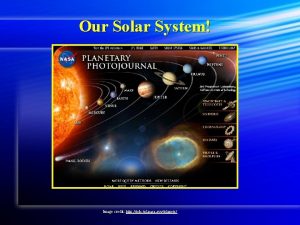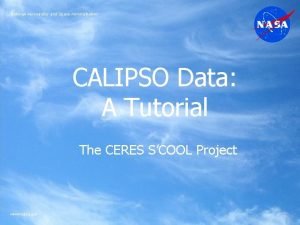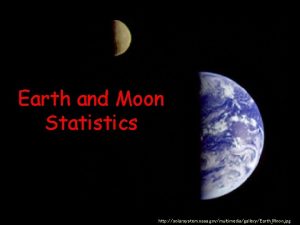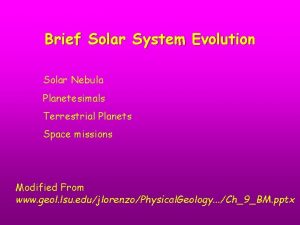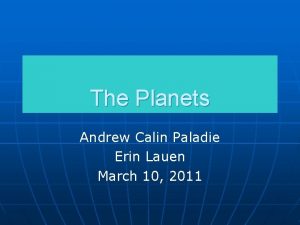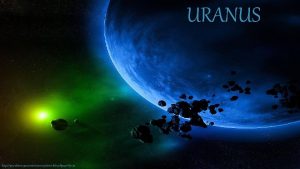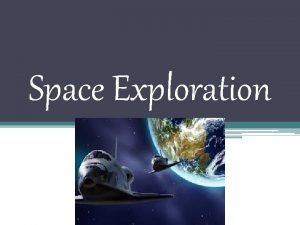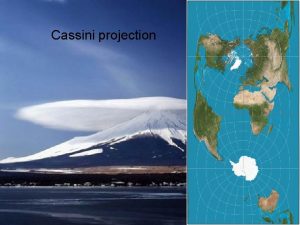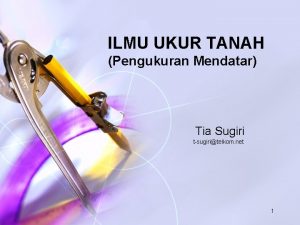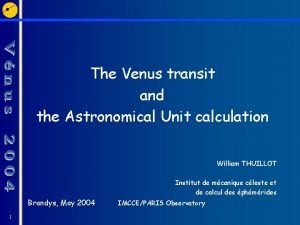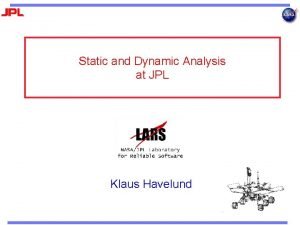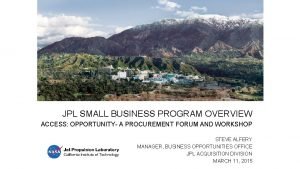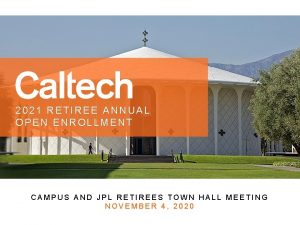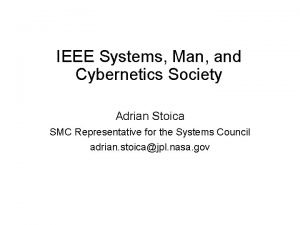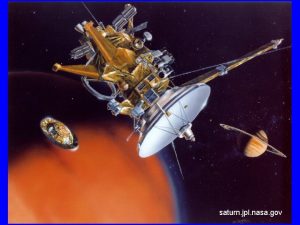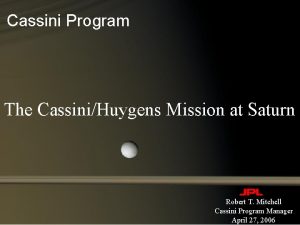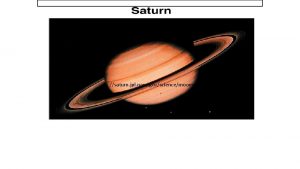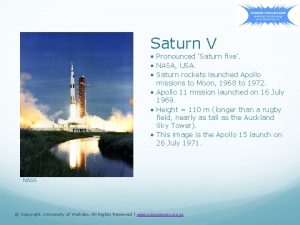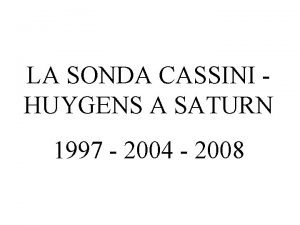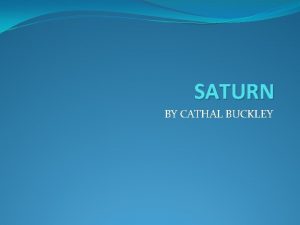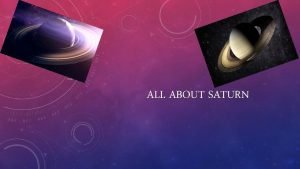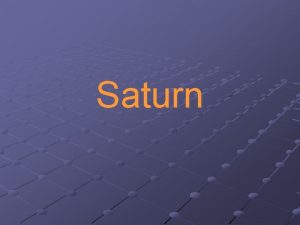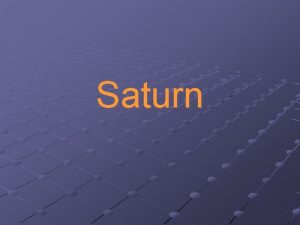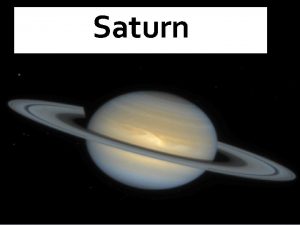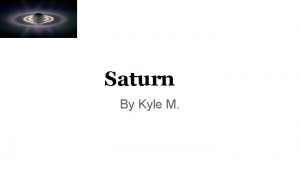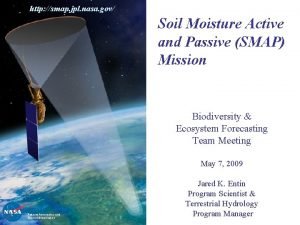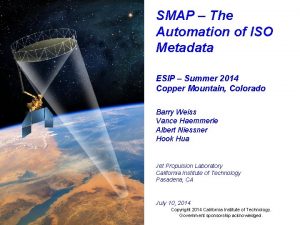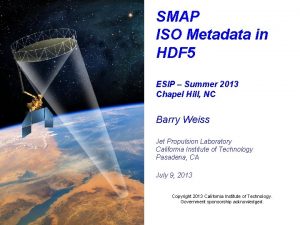http saturn jpl nasa gov CASSINIHUYGENS Cassini Huygens















- Slides: 15

http: //saturn. jpl. nasa. gov

CASSINI-HUYGENS Cassini Huygens

Cassini Born: 8 June 1625 in Perinaldo, Republic of Genoa (Italy) Died: 14 September 1712 in Paris, France He discovered Iapetus, Rhea, Tethys and Dione (1671 - 1672 - 1684) In 1675 he discovered a “gap” in Saturn's rings, Known today as the “Cassini Gap”

Huygens Born: 14 April 1629 in The Hague, Holland Died: 8 July 1695 in The Hague, Holland In 1655 he discovered Saturn’s largest moon, Titan. In 1656 he discovered the “shape” of Saturn’s rings

SATURN ¬ In mythology- Jupiter’s father ¬ Second largest planet in the solar system ¬ Gas planet ¬ Atmosphere made up of H 2 with N 2 and CH 4 ¬ Density 0. 13 x the density of the earth ¬ Mass 95 x the mass of the earth ¬ Diameter 9. 45 x the diameter of the earth ¬ Gravity 1. 16 x the gravity of the earth ¬ More than 30 natural satellites

Titan ¬Saturn’s largest moon ¬Second largest moon in the solar system ¬Bigger than Mercury ¬The only moon in the solar system known to have an atmosphere

Science Objectives - Saturn ¬ Determine the temperature field, cloud properties and composition of Saturn's atmosphere. – Image Saturn's atmosphere over a large range of latitudes and longitudes. – Determine the 2 -cm wavelength radiometer thermal emission from the sub-cloud atmosphere. – Study belt/zone structure variations in ammonia concentration. ¬ Measure the planet's global wind field, including its waves; make long-term observations of cloud features to see how they grow, evolve, and dissipate. ¬ Determine the internal structure and rotation of the deep atmosphere. – Explore the unknown dynamical properties of the atmosphere. – Examine ammonia as a tracer for atmospheric circulations. – Determine the equator-to-pole temperature gradient and unknown sub-cloud longitudinal structures. ¬ Study daily variations and relationship between the ionosphere and the planet's magnetic field. ¬ Determine the composition, heat flux, and radiation environment present during Saturn's formation and evolution. ¬ Investigate sources and nature of Saturn's lightning. http: //saturn. jpl. nasa. gov/science/index. cfm? Page. ID=53

Science Objectives - Titan ¬ Determine the most abundant elements, and most likely scenarios for the formation and evolution of Titan and its atmosphere. ¬ Determine the relative amounts of different components of the atmosphere ¬ Observe vertical and horizontal distributions of trace gases; search for complex molecules; investigate energy sources for atmospheric chemistry; determine the effects of sunlight on chemicals in the stratosphere; study formation and composition of aerosols (particles suspended in the atmosphere). ¬ Measure winds and global temperatures; investigate cloud physics, general circulation and seasonal effects in Titan's atmosphere; search for lightning. ¬ Determine the physical state, topography and composition of Titan's surface; characterize its internal structure. ¬ Investigate Titan's upper atmosphere, its ionization and its role as a source of neutral and ionized material for the magnetosphere of Saturn. ¬ Determine whether Titan's surface is liquid or solid, analyze the evidence of a bright continent as indicated in Hubble images taken in 1994. http: //saturn. jpl. nasa. gov/science/index. cfm? Page. ID=77

Key Dates ¬ 15 October 1997 – Lift-off ¬ 26 April 1998 – Venus flyby ¬ 24 June 1998 – Venus flyby ¬ 17 August 1999 – Earth flyby These flyby’s saved 64000 kg of fuel ¬ 14 April 2000 – Into the asteroid belt ¬ 05 October 2000 – First image of Jupiter ¬ 01 November 2000 – First image of Saturn ¬ 11 June 2004 – Phoebe flyby ¬ 01 July 2004 – Entry into orbit around Saturn ¬ 25 December 2004 – Huygens released from Cassini ¬ 14 January 2005 – Huygens mission to Titan ¬ 2005 to 2007 – Close flyby’s of Titan, Pandora, Enceladus, Dione, ………. http: //saturn. jpl. nasa. gov/operations/cassini-calendar-ALL. cfm

The Spacecraft ¬The largest interplanetary craft ever built. ¬It will send back 300, 000 photos of Saturn and Titan ¬It will make 70 orbits around Saturn ¬There are 12 science instruments on Cassini ¬There are 6 science instruments on Huygens

Instruments on Cassini ¬ Imaging Science Subsystem (ISS) ¬ Cassini Plasma Spectrometer takes pictures in visible, near(CAPS) explores plasma (highly ultraviolet and near-infrared light. ionised gas) within and near Saturn's magnetic field. ¬ Dual-Technique Magnetometer (MAG) studies Saturn's magnetic ¬ Composite Infrared Spectrometer field and its interactions with the solar (CIRS) measures infrared energy wind, the rings and the moons of from the surfaces, atmospheres and Saturn rings of Saturn and its moons to study their temperature and ¬ Magnospheric Imaging Instrument compositions. (MIMI) images Saturn's magnetosphere and measures ¬ Ion and Neutral Mass Spectrometer interactions between the (INMS) examines neutral and magnetosphere and the solar wind, a charged particles near Titan, Saturn flow of ionised gases streaming out and moons to learn more about their from the Sun. extended atmospheres and ionospheres. http: //saturn. jpl. nasa. gov/spacecraft/instruments-cassini-intro. cfm

Instruments on Cassini ¬ Cassini Radar (RADAR) maps surface ¬ Ultraviolet Imaging Spectrograph of Titan using radar imager to pierce (UVIS) measures ultraviolet energy veil of haze. Also used to measure from atmospheres and rings to study heights of surface features. their structure, chemistry and ¬ Radio and Plasma Wave composition. Spectrometer (RPWS) investigates ¬ Visible and Infrared Mapping plasma waves (generated by ionised Spectrometer (VIMS) identifies the gases flowing out from the Sun or chemical compositions of the orbiting Saturn), natural emissions of surfaces, atmospheres and rings of radio energy and dust. Saturn and its moons by measuring ¬ Radio Science Subsystem (RSS) colours of visible light and infrared searches for gravitational waves in the Universe; studies the atmosphere, energy emitted or reflected. rings and gravity fields of Saturn and ¬ Cosmic Dust Analyser (CDA) studies its moons by measuring telltale ice and dust grains in and near the changes in radio waves sent from the Saturn system. spacecraft. http: //saturn. jpl. nasa. gov/spacecraft/instruments-cassini-intro. cfm

Instruments on Huygens ¬ Aerosol Collector and Pyrolyser ¬ Gas Chromatograph and Mass Spectrometer (GCMS) is a versatile (ACP) will collect aerosols for gas chemical analyser designed to chemical-composition analysis. identify and quantify various Each sampling device can collect atmospheric constituents. about 30 micrograms of material. ¬ Huygens Atmosphere Structure Instrument (HASI) comprises sensors ¬ Descent Imager/Spectral for measuring the physical and Radiometer (DISR) can take electrical properties of the images and make spectral atmosphere and an on-board microphone that will send back measurements using sensors sounds from Titan. covering a wide spectral range. Doppler Wind Experiment (DWE) ¬ Surface Science Package (SSP) is a suite of sensors to determine the uses radio signals to deduce physical properties of the surface at atmospheric properties. the impact site and to provide unique information about its composition. http: //saturn. jpl. nasa. gov/spacecraft/instruments-huygens. cfm

A Selection of Images Iapetus Saturn’s Dione rings in red light Saturn’s rings in false colour Telesto http: //saturn. jpl. nasa. gov/multimedia/images/index. cfm

And still another two years to go! Watch this space!
 Http://pds.jpl.nasa.gov/planets/
Http://pds.jpl.nasa.gov/planets/ Calipso data download
Calipso data download Http://solarsystem.nasa.gov
Http://solarsystem.nasa.gov Http://earthobservatory.nasa.gov/experiments/biome/
Http://earthobservatory.nasa.gov/experiments/biome/ Http://solarsystem.nasa.gov/planets/
Http://solarsystem.nasa.gov/planets/ Http://solarsystem.nasa.gov/planets/
Http://solarsystem.nasa.gov/planets/ Uranus founder
Uranus founder Http://history.nasa.gov/sputnik/
Http://history.nasa.gov/sputnik/ Low latitude
Low latitude Contoh soal metode cassini
Contoh soal metode cassini Cassini mars
Cassini mars Http //mbs.meb.gov.tr/ http //www.alantercihleri.com
Http //mbs.meb.gov.tr/ http //www.alantercihleri.com Jpl c coding standard
Jpl c coding standard Jpl siri
Jpl siri 8776441774
8776441774 Adrian stoica jpl
Adrian stoica jpl
